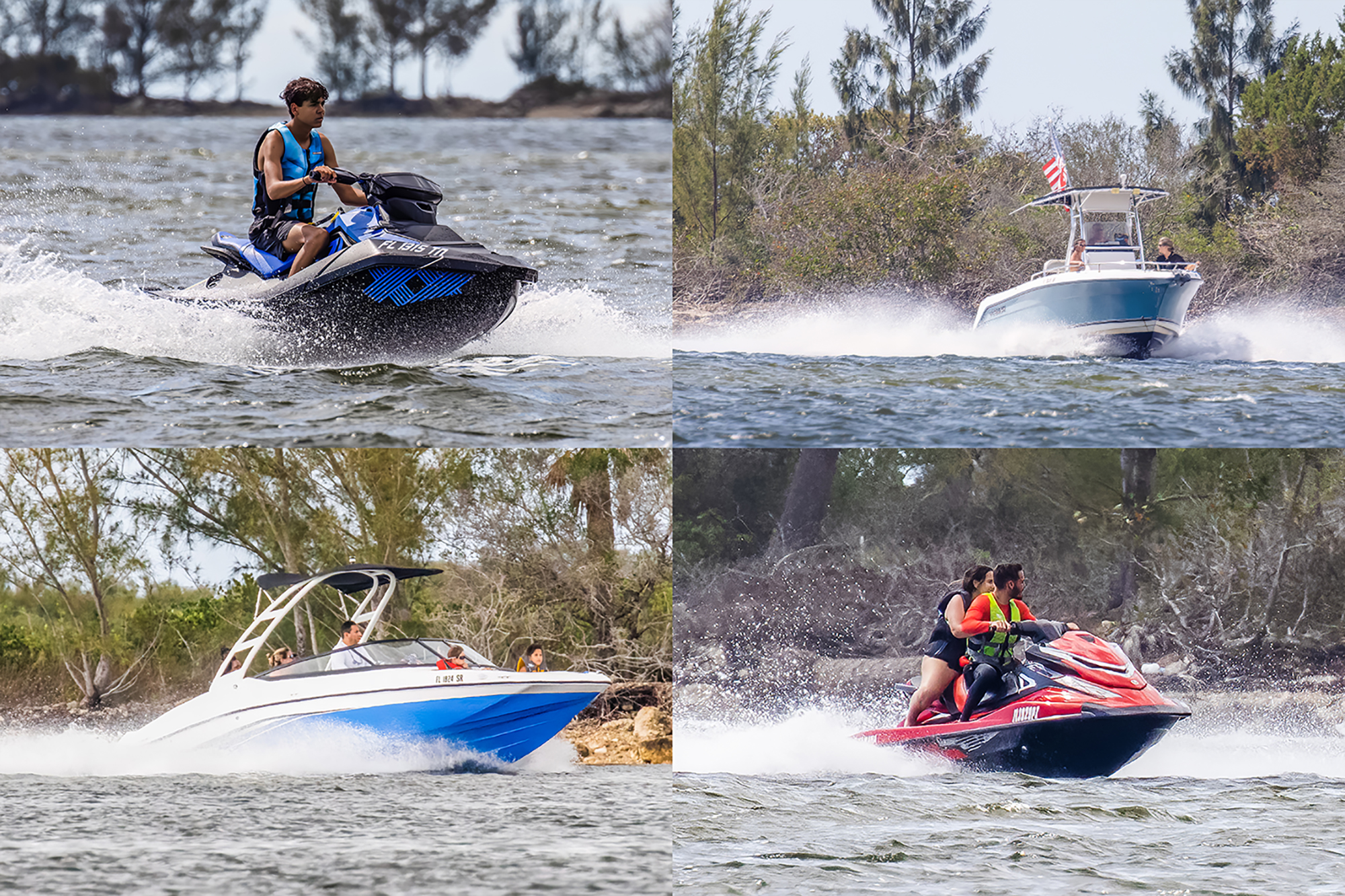HERNANDO BEACH
Boating Regulations in Florida
What do the red and green markers in the water mean?
Red and green markers are an essential part of navigational aids in waterways that signal the direction of safe travel. Red markers indicate the port (left) side of a waterway, while green markers signify the starboard (right) side. Knowing and following these markers ensure safe navigation and prevent boat accidents.
When entering a channel from the open sea or traveling upstream (returning), keep the red markers on your right (starboard side). Notice these red markers contain even numbers, which should increase as you proceed inland.
When traveling toward open water (seaward), keep the green markers on your right (starboard side). The green markers contain odd numbers, which should decrease as you proceed toward open water.
HERNANDO BEACH
Boating Regulations in Florida
Personal Floatation Devices (Life Jackets)
Any vessel measuring less than 26 feet in length that is underway in Florida state waters must have all boaters or passengers who are under 6 years old wearing a U.S. Coast Guard-approved Type I, II, or III personal flotation device (PFD). The owner and/or operator of the vessel is responsible for providing, storing, maintaining, and using all safety equipment mandated by the U.S. Coast Guard. “Underway” is defined as any time the vessel is not anchored, moored, made fast to the shore, or aground.
- The State of Florida requires one wearable Type I, II, III, or V PFD for each person aboard any vessel.
- Ensure PFDs are readily accessible.
- At least one Type IV (throwable device) PFD must be kept on board any vessel 16 feet or longer.
- Someone being towed behind a vessel must wear a PFD.
Alcohol & Boating Under the Influence (BUI)
In Florida, operating a vessel while impaired by alcohol or other drugs is prohibited. If a vessel operator is suspected of being impaired, they must undergo sobriety tests and a physical or chemical test to determine the content of alcohol in their blood or breath. If the blood- or breath-alcohol level is at or above 0.08%, that person is considered to be under the influence. Additionally, anyone under the age of 21 with a breath-alcohol level of 0.02% or higher while operating or in physical control of a vessel is also in violation of this law.
Boating under the influence (BUI) is a serious crime in the state of Florida. BUI is defined as operating a vessel while impaired by the influence of alcohol or any other drugs.Boating under the influence can be extremely dangerous and put the lives of everyone on the vessel, as well as other vessels around them, at risk. Operating a vessel while impaired can lead to impaired judgment, slower reaction times, and an inability to navigate properly. To ensure safety on the water, vessel operators must adhere to these laws and never operate a vessel if they have had too much to drink.
Safe Boating vs. Reckless and Careless Operation
The operation of a vessel with willful disregard for the safety of persons or property is a first-degree misdemeanor in Florida. All vessel operators are responsible for operating in a reasonable and careful manner, taking into consideration other vessel traffic, posted restrictions, divers-down flags, and other potential dangers. Failure to do so constitutes careless operation and is a non-criminal infraction. Furthermore, violations of the Federal Navigation Rules are also violations of Florida law.
Water Ski Regulations
When towing someone on skis or another aquaplaning device, the operator of the vessel must either have an observer onboard who is accountable to the skier or use a wide-angle rear-view mirror. Furthermore, skiing or aquaplaning between 1/2 hour past sunset and 1/2 hour before sunrise is not allowed. Additionally, those engaging in this activity must wear a U.S. Coast Guard-approved non-inflatable wearable PFD, as inflatable PFDs are prohibited. Operating a vessel while impaired by alcohol or other drugs is also unlawful. Finally, the operator must not tow the skier close enough to any fixed object or other vessel that it could lead to a collision.
Be Aware of Seagrass Areas
Seagrasses provide vital habitats for a variety of marine life, including the endangered manatees and green sea turtles, serve as natural filters to help purify the water, and provide a suitable environment for marine life. To protect these vital habitats, boaters should make it a priority to avoid running through seagrass beds when possible. Navigation charts often identify seagrass beds as light green or as “grs” on the chart. Additionally, boaters should stay within marked navigation channels when exploring unfamiliar waterways, and should avoid taking shortcuts through seagrass beds to avoid causing propeller scars. Damaging seagrass beds is a violation of Florida law in some areas of state waters.
Idle Speed & No Wake Zone
In some areas of Florida waterways, boat speed is restricted with the use of signage. These signs serve as protection for the endangered manatees or for boating safety purposes, so it is important that vessel operators are aware of them and abide by the speed regulations. “Idle Speed, No Wake” Zones indicate that vessels must only be operated at a speed necessary to maintain steerage and headway and should not cause a wake at this speed.
The canals in Hernando Beach are No-Wake Zones, so please slow down in these areas. Living in Hernando Beach we see boats going through the canals at high speeds. Please be considerate of others and for your own safety, SLOW DOWN!
Diving & Snorkeling
State law requires scuba divers or snorkelers to display a “diver down” flag whenever they are in the water. This flag is typically square or rectangular and red in color, with a white diagonal stripe, and is made from a stiffened material so it can be held unfurled and extended. All boaters must make effort to stay at least 300 feet away from dive flags in open water and 100 feet away in rivers, inlets, and navigation channels. If, however, a boater must come closer than the designated distance, they must slow their vessel to the minimum speed required to maintain forward motion and steering.
Law Enforcement – Getting “Pulled Over”
Law enforcement officers in the state of Florida, including those of the Florida Fish and Wildlife Conservation Commission, local sheriffs offices, and municipal police departments, all have the authority to remove or relocate any vessels deemed to be an interference with navigation or a hazard to public safety. These officers also have the power to enforce all boating safety laws and to conduct vessel inspections. Moreover, they may conduct spot checks on any vessels to ensure compliance with boating safety equipment and registration regulations, as well as resource inspections in accordance with state law.
Blind Curve and Rock Areas
Going out to the Flats in Hernando Beach, you’ll see a blind curve at Marker 37. Please be careful going around the curve, slow down as needed and be aware of boats coming from the other side. The Hernando Beach Channel is very narrow, not too much room for errors. In this curve you cannot see boaters returning to Hernando Beach. Slow down, stay on the right side and be aware of your surroundings.
You’ll also notice several signs in and out of the canals that say “Danger! Rock Area!”. These signs are there for a reason, they mean that there’s a rock on the sea floor. Every day we see beaters that disregard the red markers on their right, trying to take a shortcut. It so happens that literally every day someone hits the sea floor or the rock beneath them. It hurts to see beautiful boats getting damaged because of taking a shortcut.













